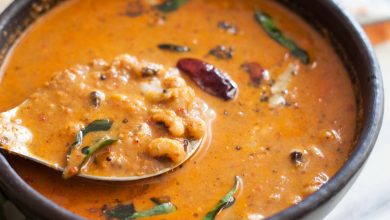Nepalese Style Dhal Bhat Recipe
Nepalese cuisine is rich in flavors and tradition, and one of its most cherished dishes is Dhal Bhat. This hearty and nutritious meal, primarily made with yellow moong dal, is not just a staple for many Nepalese families but also a favorite across the globe. It’s a delightful combination of lentils and rice, often served with an array of vegetable dishes that complement the meal beautifully. The beauty of Dhal Bhat lies not only in its comforting texture but also in its health benefits, especially for those seeking high-protein vegetarian options.
Ingredients
| Ingredient | Quantity |
|---|---|
| Yellow Moong Dal (Split) | 2 cups |
| Onion (chopped) | 1 medium-sized onion |
| Turmeric Powder (Haldi) | 1/4 teaspoon |
| Coriander Leaves (Dhania) | 2 sprigs (chopped) |
| Salt | To taste |
| Cinnamon Stick (Dalchini) | 1 inch |
| Cardamom Powder (Elaichi) | 2 pods |
| Cloves (Laung) | 4 cloves |
| Dry Red Chillies | 2 dry red chillies |
| Whole Black Peppercorns | 1 teaspoon |
| Cumin Seeds (Jeera) | 1 teaspoon |
Preparation Time
| Preparation Time | 10 minutes |
|---|
Cooking Time
| Cooking Time | 30 minutes |
|---|
Total Time
| Total Time | 40 minutes |
|---|
Servings
| Servings | 4 |
|---|
Cuisine
| Cuisine | Nepalese |
|---|
Course
| Course | Lunch |
|---|
Dietary Information
| Diet | High Protein Vegetarian |
|---|
Instructions
-
Prepare the Dal: Begin the preparation of the Nepalese Style Dhal Bhat by rinsing the yellow moong dal thoroughly under running water to remove any impurities. In a pressure cooker, combine the rinsed dal with enough water, turmeric powder, and salt. Cook for approximately 4 whistles or until the dal becomes soft and mushy. This step is crucial as it ensures a creamy texture for your dish.
-
Grind the Spices: While the dal is cooking, take the whole spices — cinnamon stick, cardamom, cloves, dry red chillies, black peppercorns, and cumin seeds — and place them into a mixer grinder. Grind these spices to a smooth powder, adding a small amount of water if necessary to help with the grinding process. The fragrant aroma of freshly ground spices will elevate the dish significantly.
-
Sauté the Onion: Heat 2 tablespoons of cooking oil in a kadai or deep skillet over medium heat. Once hot, add the chopped onion. Sauté the onions until they turn translucent, allowing them to soften and release their natural sweetness, which will enhance the overall flavor of the dhal.
-
Combine and Cook: Once the onions are sautéed, add the freshly ground spice mixture to the kadai. Stir well and cook for a few minutes, letting the spices bloom and their flavors meld together. Once the spices are fragrant, add the boiled and mashed dal into the kadai. Stir to combine, ensuring the spices are evenly distributed throughout the dal.
-
Adjust Consistency: As you mix, begin to mash the dal with the back of a spoon or a masher to achieve your desired consistency. If the dal appears too thick, you can add a little water to loosen it. Keep the heat low and continue to cook for another 5–10 minutes, allowing the raw smell of the spices to dissipate and the flavors to deepen.
-
Final Touches: Once cooked, taste the dhal and adjust the salt as necessary. Just before serving, sprinkle the chopped coriander leaves over the top for a fresh, herbal note that adds brightness to the dish.
Serving Suggestions
Serve the Nepalese Style Dhal Bhat hot, accompanied by a side of fragrant rice to soak up the delicious lentil stew. For a well-rounded meal, pair it with vegetable curries such as cauliflower and aloo subzi or baby corn and carrot subzi. This combination not only adds color and nutrition to your plate but also enhances the overall experience of enjoying this traditional dish.
Nutritional Information (per serving)
| Nutrient | Value |
|---|---|
| Calories | Approx. 320 kcal |
| Protein | Approx. 15 g |
| Carbohydrates | Approx. 60 g |
| Dietary Fiber | Approx. 8 g |
| Total Fat | Approx. 5 g |
| Saturated Fat | Approx. 1 g |
Conclusion
The Nepalese Style Dhal Bhat is more than just a meal; it’s a comforting embrace of tradition and flavor. Whether enjoyed during a simple lunch or as part of a festive gathering, this dish brings a taste of Nepalese culture to your table. By following these steps and infusing your cooking with love and patience, you can create a dish that not only nourishes the body but also warms the heart. Enjoy every bite of this delightful meal!




